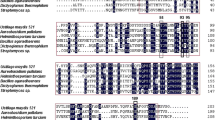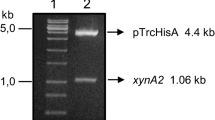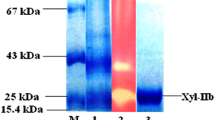Abstract
A gene encoding a xylanase, named xynS20, was cloned from the ruminal fungus Neocallimastix patriciarum. The DNA sequence of xynS20 revealed that the gene was 1,008 bp in size and encoded amino acid sequences with a predicted molecular weight of 36 kDa. The amino acid sequence alignment showed that the highest sequence identity (28.4%) is with insect gut xylanase XYL6805. According to the sequence-based classification, a putative conserved domain of glycosyl hydrolase family 11 was detected at the N-terminus of XynS20 and a putative conserved domain of family 1 carbohydrate-binding module (CBM) was observed at the C-terminus of XynS20. An Asn-rich linker sequence was found between the N-terminal catalytic domain and the C-terminal CBM of XynS20. To examine the activity of the gene product, xynS20 gene was cloned as an oleosin-fused protein, expressed in Escherichia coli, affinity-purified by formation of artificial oil bodies, released from oleosin by intein-mediated peptide cleavage, and finally harvested by concentration of the supernatant. The specific activity of purified XynS20 toward oat spelt xylan was 1,982.8 U mg−1. The recombinant XynS20 was stable in the mild acid pH range from 5.0 to 6.0, and the optimum pH was 6.0. The optimal reaction temperature of XynS20 was 45°C; at temperatures below 30 and above 55°C, enzyme activity was less than 50% of that at the optimal temperature.




Similar content being viewed by others
References
Altschul SF, Madden TL, Schaffer AA, Zhang J, Zhang Z, Miller W, Lipman DJ (1997) Gapped BLAST and PSI-BLAST: a new generation of protein database search programs. Nucleic Acids Res 25:3389–3402
Beguin P (1983) Detection of cellulase activity in polyacrylamide gels using Congo red-stained agar replicas. Anal Biochem 131:333–336
Bendtsen JD, Nielsen H, von Heijne G, Brunak S (2004) Improved prediction of signal peptides: SignalP 3.0. J Mol Biol 340:783–795
Brennan YL, Callen WN, Christoffersen L, Dupree P, Goubet F, Healey S, Hernández M, Keller M, Li K, Palackal N, Sittenfeld A, Tamayo G, Wells S, Hazlewood GP, Mathur EJ, Short JM, Robertson DE, Steer BA (2004) Unusual microbial xylanases from insect guts. Appl Environ Microbiol 70:3609–3617
Brookman JL, Mennim G, Trinci AP, Theodorou MK, Tuckwell DS (2000) Identification and characterization of anaerobic gut fungi using molecular methodologies based on ribosomal ITS1 and 18S rRNA. Microbiology 146:393–403
Bryant MP (1972) Commentary on the Hungate technique for culture of anaerobic bacteria. Am J Clin Nutr 25:1324–1328
Chiang CJ, Chen HC, Chao YP, Tzen JTC (2005) Efficient system of artificial oil bodies for functional expression and purification of recombinant nattokinase in Escherichia coli. J Agric Food Chem 53:4799–4804
Collins T, Gerday C, Feller G (2005) Xylanases, xylanase families and extremophilic xylanases. FEMS Microbiol Rev 29:3–23
Coutinho PM, Henrissat B (1999) Carbohydrate-active enzymes: an integrated database approach. In: Gilbert HJ, Davies G, Henrissat B, Svensson B (eds) Recent advances in carbohydrate bioengineering. The Royal Society of Chemistry, Cambridge, pp 3–12
Denman S, Xue GP, Patel B (1996) Characterization of a Neocallimastix patriciarum cellulase cDNA (celA) homologous to Trichoderma reesei cellobiohydrolase II. Appl Environ Microbiol 62:1889–1896
Ferreira LMA, Durrant AJ, Hall J, Hazlewood GP, Gilbert HJ (1990) Spatial separation of protein domains is not necessary for catalytic activity or substrate binding in a xylanase. Biochem J 269:261–264
Hall TA (1999) BioEdit: a user-friendly biological sequence alignment editor and analysis. Nucl Acids Symp 41:95–98
Hashimoto H (2006) Recent structural studies of carbohydrate-binding modules. Cell Mol Life Sci 63:2954–2967
Ho YW, Bauchop T (1991) Morphology of three polycentric rumen fungi and description of a procedure for the induction of zoosporogenesis and release of zoospores in cultures. J Gen Microbiol 137:213–217
Huang YH, Huang CT, Hseu RS (2005) Effects of dockerin domains on Neocallimastix frontalis xylanases. FEMS Microbiol Lett 243:455–460
Konig J, Grasser R, Pikor H, Vogel K (2002) Determination of xylanase, β-glucanase, and cellulase activity. Anal Bioanal Chem 374:80–87
Kulkarni N, Shendye A, Rao M (1999) Molecular and biotechnological aspects of xylanases. FEMS Microbiol Rev 23:411–456
Laemmli UK (1970) Cleavage of structural proteins during the assembly of the head of bacteriophage T4. Nature 227:680–685
Lehtio J, Sugiyama J, Gustavsson M, Fransson L, Linder M, Teeri TT (2003) The binding specificity and affinity determinants of family 1 and family 3 cellulose binding modules. Proc Natl Acad Sci USA 100:484–489
Li XL, Chen H, Ljungdahl LG (1997) Monocentric and polycentric anaerobic fungi produce structurally related cellulases and xylanases. Appl Environ Microbiol 63:628–635
Lineweaver H, Burk D (1934) The determination of enzyme dissociation constants. J Am Chem Soc 57:685
Liu JH, Selinger LB, Cheng K-J, Beauchemin KA, Moloney MM (1997) Plant seed oil-bodies as an immobilization matrix for a recombinant xylanase from the rumen fungus Neocallimastix patriciarum. Mol Breeding 3:463–470
Liu JH, Selinger LB, Tsai CF, Cheng K-J (1999) Characterization of a Neocallimastix patriciarum xylanase gene and its product. Can J Microbiol 45:970–974
Lowry OH, Rosebrough NJ, Farr AL, Randall RJ (1951) Protein measurement with the folin-phenol reagent. J Biol Chem 193:256–275
Page RD (1996) TreeView: an application to display phylogenetic trees on personal computers. Comput Appl Biosci 12:357–358
Peng CC, Shyu DJH, Chou WM, Chen MJ, Tzen JTC (2004) Method for bacterial expression and purification of sesame cystatin via artificial oil bodies. J Agric Food Chem 52:3115–3119
Polizeli MLTM, Rizzatti ACS, Monti R, Terenzi HF, Jorge JA, Amorim DS (2005) Xylanases from fungi: properties and industrial applications. Appl Microbiol Biotechnol 67:577–591
Poon DKY, Withers GS, McIntosh LP (2007) Direct demonstration of the flexibility of the glycosylated praline–threonine linker in the Cellulomonas fimi xylanase Cex through NMR spectroscopic analysis. J Biol Chem 282:2091–2100
Raghothama S, Simpson PJ, Szabo L, Nagy T, Gilbert HJ, Williamson MP (2000) Solution structure of the CBM10 cellulose binding module from Pseudomonas xylanase A. Biochemistry 39:978–984
Sambrook J, Russell DW (2001) Molecular cloning: a laboratory manual, 3rd ed. Cold Spring Harbor Laboratory, NY
Selinger LB, Forsberg CW, Cheng KJ (1996) The rumen: a unique source of enzymes for enhancing livestock production. Anaerobe 2:263–284
Shen H, Schmuck M, Pilz I, Gilkes NR, Kilburn DG, Miller Jr RC, Warren RA (1991) Deletion of the linker connecting the catalytic and cellulose-binding domains of endoglucanase A (CelA) of Cellulomonas fimi alters its conformation and catalytic activity. J Biol Chem 266:11335–11340
Srisodsuk M, Reinikainen T, Penttila M, Teeri TT (1993) Role of the interdomain linker peptide of Trichoderma reesei cellobiohydrolase I in its interaction with crystalline cellulose. J Biol Chem 268:20756–20761
Subramaniyan S, Prema P (2002) Biotechnology of microbial xylanases: enzymology, molecular biology, and application. Crit Rev Biotechnol 22:33–64
Teather RM, Wood PJ (1982) Use of Congo red–polysaccharide interactions in enumeration and characterization of cellulolytic bacteria from the bovine rumen. Appl Environ Microbiol 43:777–780
Thompson JD, Higgins DG, Gibson TJ (1994) CLUSTAL W: improving the sensitivity of progressive multiple sequence alignment through sequence weighting, position-specific gap penalties and weight matrix choice. Nucleic Acids Res 22:4673–4680
Wu S, Liu B, Zhang X (2006) Characterization of a recombinant thermostable xylanase from deep-sea thermophilic Geobacillus sp. MT-1 in East Pacific. Appl Microbiol Biotechnol 72:1210–1216
Zhang JX, Flint HJ (1992) A bifunctional xylanase encoded by the xynA gene of the rumen cellulolytic bacterium Ruminococcus flavefaciens 17 comprises two dissimilar domains linked by an asparagine/glutamine-rich sequence. Mol Microbiol 6:1013–1023
Acknowledgements
This research was conducted using funds partially provided by grants NSC 95-2313-B-002-118-MY3 and NSC 97-ET-7-002-006-ET from the National Science Council and grant 95AS-5.1.3-AD-U1(3) from the Council of Agriculture, Republic of China.
Author information
Authors and Affiliations
Corresponding authors
Rights and permissions
About this article
Cite this article
Liu, JR., Duan, CH., Zhao, X. et al. Cloning of a rumen fungal xylanase gene and purification of the recombinant enzyme via artificial oil bodies. Appl Microbiol Biotechnol 79, 225–233 (2008). https://doi.org/10.1007/s00253-008-1418-1
Received:
Revised:
Accepted:
Published:
Issue Date:
DOI: https://doi.org/10.1007/s00253-008-1418-1




